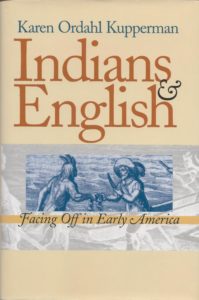Karen Ordahl Kupperman’s latest book addresses a more specific topic than the title Indians and English: Facing Off in Early America suggests. She examines English relations with Algonquian-speaking peoples in the first few decades of English settlement on the eastern seaboard of North America. Roanoke, Jamestown, and Plymouth are the primary settings for her study, but she also brings in material from early Maryland and Connecticut. Since Kupperman has already published extensively on seventeenth-century English-Indian interactions, one might expect this book to be a synthesis of her earlier work. Instead, it offers a new interpretive framework for conceptualizing how Europeans came to know the Native people of the Americas.
Her argument is complex and subtle, by necessity, for Kupperman proposes that English responses to Indians were mixed. English commentators describing their experiences in the New World had an incentive to present Indians in the best possible light. The American environment had to be portrayed as healthful and productive to justify colonization, and so English writers depicted Native American people, the product of that environment, as intelligent, inventive, and moral beings. English colonists also saw in Native cultures attributes that reminded them of their own Saxon heritage as celebrated in Tacitus’s history of ancient Germans and Britons. Thus, the English could readily envision Native cultures as being both primitive and noble, just as they imagined their own ancestors to have been in the past. However, according to Kupperman, not all written accounts of Indians can be classified as representations buttressing up an English sense of self. Because the English were also curious about these new people and uncertain about how to get along with them, Indians appearing in English records should be considered more than just “mirror images” (the title of chapter 1) and as real people who influenced English actions and English perceptions of them.
Kupperman’s argument is so sensible, it is surprising in retrospect that no previous historian has ventured to make the same case. The scholarly enterprise, particularly the need to pursue a single-minded thesis, does not allow for much exploration of the contradictions and ambiguities that Kupperman shows were constant features of English-Indian relations. Kupperman establishes order amid the cacophony of discordant voices by approaching the problem thematically. In successive chapters on “Reading Indian Bodies,” political structures, religious practices, and economies, she persuasively contends that the English recognized the essential humanity of Indians and the complex social and cultural institutions that humanity entailed. The last two chapters, in the spirit of mixed and contradictory developments in English-Indian relations, deal with “Incorporating the Other” and “Resisting the Other.” Throughout the book, her examples are richly detailed and her collection of source material wide-ranging.
I have no criticisms of the book itself and recommend it for its thought-provoking reinterpretation of English colonists’ perceptions of Indians. I do, however, think the title of the book and the promotional blurb on the book jacket misrepresent the book’s achievements by implying that it fits within the expanding literature on Indian and European encounters as represented by Richard White’s The Middle Ground: Indians, Empires, and Republics in the Great Lakes Region, 1650-1815 (1991) and by the work of James Axtell, James Merrell, Daniel Richter, and so on. Phrases such as Indians & English, “All parties in these dramas were uncertain . . .”, and “Indians and English both believed . . .” suggest that the book intends to explicate how both Indians and Europeans perceived of each other and were changed by their evolving relationships. The book does give some inkling of what Indians must have been thinking about the English, particularly so in a thoroughly fascinating recounting of Pocahontas and her entourage on the fatal trip to England. And Kupperman also brings in insights and information derived from Indian oral traditions that have appeared in print in the writings of twentieth-century tribal historians. But there is no chapter called “Reading English Bodies” complementing the chapter on “Reading Indian Bodies,” just one of many indications that the book belongs more to the historiography on European images of Indians, such as in Robert F. Berkhofer Jr.’s The White Man’s Indian (1978).
Although Indian perspectives fall outside the book’s main purpose, it can still be asserted, as on the book jacket, that Kupperman “argues convincingly that we must see both Indians and English as active participants in this unfolding drama.” Indeed, the book’s claim that Indians were not passive but active agents in the making of history lies at the heart of Kupperman’s argument and constitutes Indians & English’s most significant contribution. English colonists were well aware of their Indian acquaintances’ power to shape and alter the course of events, and so Indians were active agents in that sense. Moreover, as Europeans developed images of American Indians, personal experiences intermingled with culturally engrained expectations to make for a constantly shifting conglomeration of ideas about who Indians were. Too often, scholars looking for the origins of stereotypes or images of Indians look only to the European past for the prototypes that were then applied to Indians. As Kupperman shows, early English ideas about Native Americans traveled a more twisted, tangled path.
This article originally appeared in issue 1.2 (January, 2001).
Nancy Shoemaker is an Associate Professor of History at the University of Connecticut-Storrs.



















